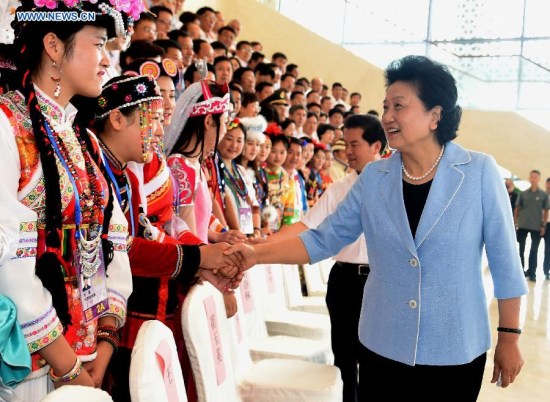
Chinese Vice Premier Liu Yandong (R front) meets with delegates from teams competing in the 10th National Traditional Games of Ethnic Minorities of China in Ordos, north China's Inner Mongolia Autonomous Region, Aug. 9, 2015. (Photo: Xinhua/Ren Junchuan)
Chinese Vice Premier Liu Yandong declared Sunday the opening of the 10th Chinese Ethnic Games, which draws 6,240 athletes from all 56 ethnic groups of China competing or performing in nearly 200 Chinese traditional sport events in the coming eight days.
It's truely an exclusive experience to see the athletes parade into the main stadium as each of the 34 delegations, including Taiwan delegation, presented a short program of strong ethnic flavor. The opening ceremony is much like a fashion show, tradition retrospection and culture exhibition for spectators.
Multiple ethnic groups demonstrated their traditional dances and songs, including groups of Tibet, Uyghur, Mongolia, Zhuang, Hui, Korea, Yi, Miao, etc. Not quite like the other sports event, the Ethnic Games is much more a culture feat and tradition inheriting festival.
The Mongolian artists gave a gorgeous performance in memory of their glorious history and the perpetual Mongolian hero Genghis Khan.
Zhang Xiaoping, a Mongolian native and the boxing champion of the Beijing Olympics, is the last torch relay bearer, who lit the torches carried by 56 representatives from all 56 Chinese ethnic groups and the 57 torch carriers lit up the cauldron all together.
The host city Ordos, which means "Many Palaces" in Mongolian, has achieved miraculous economic progress in recent years. Ordos' GDP has been expanding from 59.4 billion yuan (9.6 billion US dollars) in 2005 to 416.2 billion yuan (67.1 billion US dollars) in 2014.
With 62-year history, the quadrennial games serves as a get-together party for China's 56 ethnic groups and has been playing a key role in keeping China's multiple traditional sports alive.
Back to November 1953, nearly 400 athletes from China's 13 ethnic groups participated in the inaugural ethnic games in Tianjin Municipality, a harbor city in North China, contesting in weightlifting, boxing, wrestling and a couple of traditional sports.
The first ethnic games lasted five days, attracting a total of 120,000 spectators. It is also the first ever multiple-sport event in the world's most populous country after the founding of the People's Republic of China.h Then it had been waiting for 29 years to see the second edition in Hohhot, the capital city of Inner Mongolia in 1982, with 55 ethnic groups participating, excluding ethnic Han.
Since 1991, the ethnic games has been settled as a quadrennial event, featuring ethnic sports and characteristics of China's 55 ethnic minorities, which account for less than nine percent of the country's 1.3-billion population.
The ethnic games offers chances for people from China's rural and border areas to present their unique skills and cultures. In 2007, Tibetan athlete Dahi traveled on a train for the first time in his life after he had been selected to the Gansu delegation to attend the eighth ethnic games in Guangzhou, the capital city of Guangdong, one of the most prosperous provinces in China.
The stalwart Tibetan herdsman, born on the Qinghai-Tibet Plateau, barely slept during his 36-hour trip because he didn't want to miss any view along the rail.
"My hometown is full of snow, but here flowers are everywhere," said the father of three, recalling his first experience outside Tibet.
Many traditional sports are both enjoyable and skillful. Thanks to the games, many ethnic traditions can be preserved even if they are no longer necessary for keeping daily lives running due to the modernization.
Single bamboo drifting, which originated from Guizhou province and once worked as local transportation method, was introduced to the ethnic games as a title event four years ago. Athletes need to stand on a seven-meter-long bamboo pole and use a much thinner bamboo in hands as an oar to glide on water.
There will be 17 title events and 178 exhibition events in the games including dragon-boat race, stilts running race, board shoes race.
For the first time, athletes from the Han ethnic group are allowed to participate in team events with a limit of one third in the squad.
The ethnic games prioritizes cultural exchange, ethnic interaction and mutual understanding more than competition, recognizing and upholding culture differences and ethnic features.


















































